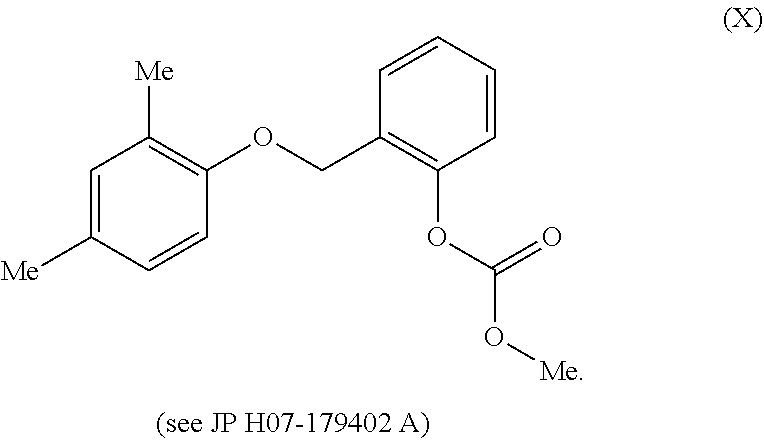Aromatic compound and use thereof
- Summary
- Abstract
- Description
- Claims
- Application Information
AI Technical Summary
Benefits of technology
Problems solved by technology
Method used
Image
Examples
production example 1
[0123]A mixture of 0.23 g of 2-(bromomethyl)phenyl=acetate, 0.24 g of 4A mentioned in Reference Production Example 4, 0.28 g of potassium carbonate, and 4 mL of acetonitrile was stirred with heating under reflux for 4 hours. After cooling, water was added to the reaction solution and the mixture was extracted with ethyl acetate. The organic layer was washed with water and a saturated saline solution, dried over anhydrous magnesium sulfate, and then concentrated under reduced pressure. The residue thus obtained was subjected to silica gel column chromatography to obtain 0.15 g of the present compound 1.
[0124]1H-NMR (CDCl3) δ: 7.57-7.53 (1H, m), 7.47-7.45 (1H, m), 7.40-7.35 (2H, m), 7.30-7.27 (1H, m), 7.15-7.11 (1H, m), 6.90 (1H, d, J=8.5 Hz), 5.06 (2H, s), 3.86 (3H, s), 2.34 (3H, s), 2.28 (3H, s), 2.15 (3H, s).
[0125]In accordance with the method mentioned in Production Example 1, the present compound 2 was synthesized.
[0126]The structural formulas and 1H-NMR data thereof are shown be...
production example 2
[0128]To a mixture of 0.36 g of 7A mentioned in Reference Production Example 7, 0.095 g of methyl chlorocarbonate and 4 mL of chloroform, 0.42 ml of triethylamine was added, followed by stirring at room temperature for 4 hours. After the reaction solution was concentrated under reduced pressure, the residue thus obtained was subjected to silica gel column chromatography to obtain 0.30 g of the present compound 3.
[0129]1H-NMR (CDCl3) δ: 7.44-7.41 (2H, m), 7.34-7.28 (1H, m), 7.16 (1H, d, J=7.6 Hz), 7.07 (1H, d, J=8.2 Hz), 7.03 (1H, d, J=8.2 Hz), 5.06 (2H, s), 3.86 (3H, s), 3.84 (3H, s), 2.46 (3H, s), 2.20 (3H, s), 2.17 (3H, s).
[0130]In accordance with the method mentioned in Production Example 2, the present compounds 4 to 5 and 8 to 10 were synthesized.
[0131]The structural formulas and 1H-NMR data thereof are shown below.
Present Compound 4
[0132]1H-NMR (CDCl3) δ: 7.45-7.41 (2H, m), 7.29-7.25 (1H, m), 7.11-7.09 (1H, m), 7.05-7.01 (2H, m), 5.04 (2H, s), 3.87 (3H, s), 3.15 (3H, s), 3.04 ...
production example 3
[0137]To a mixture of 0.36 g of 10A mentioned in Reference Production Example 10, 0.14 ml of triethylamine, and 2 ml of tetrahydrofuran under ice cooling, 0.30 g of triphosgene was added at room temperature, followed by stirring for 2 hours. To the reaction solution, methylamine (7% tetrahydrofuran solution) was added, followed by stirring at room temperature for 2 hours. The reaction solution was concentrated under reduced pressure and the residue thus obtained was subjected to silica gel column chromatography to obtain 0.20 g of the present compound 6.
[0138]1H-NMR (CDCl3) δ: 7.47-7.45 (1H, m), 7.38-7.35 (2H, m), 7.22-7.13 (2H, m), 6.91 (1H, d, J=8.5 Hz), 5.07 (2H, s), 5.02-4.97 (1H, m), 3.86 (3H, s), 2.89 (3H, d, J=5.0 Hz), 2.31 (3H, s), 2.24 (3H, s), 2.15 (3H, s).
[0139]In accordance with the method mentioned in Production Example 3, the present compounds 11 to 14 were synthesized.
[0140]The structural formulas and 1H-NMR data thereof are shown below.
Present Compound 11
[0141]1H-NMR...
PUM
 Login to View More
Login to View More Abstract
Description
Claims
Application Information
 Login to View More
Login to View More - R&D
- Intellectual Property
- Life Sciences
- Materials
- Tech Scout
- Unparalleled Data Quality
- Higher Quality Content
- 60% Fewer Hallucinations
Browse by: Latest US Patents, China's latest patents, Technical Efficacy Thesaurus, Application Domain, Technology Topic, Popular Technical Reports.
© 2025 PatSnap. All rights reserved.Legal|Privacy policy|Modern Slavery Act Transparency Statement|Sitemap|About US| Contact US: help@patsnap.com



